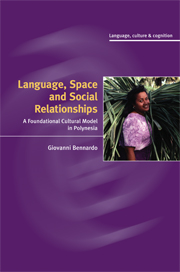Book contents
- Frontmatter
- Contents
- List of figures
- List of tables
- Preface
- Acknowledgments
- List of abbreviations
- 1 A foundational cultural model in Tongan language, culture, and social relationships
- 2 The Kingdom of Tonga: country, people, and language
- Part I Space in Tongan language, culture, and cognition
- Part II Radiality
- 6 The radiality hypothesis
- 7 Radiality in possession and time
- 8 Radiality and the Tongan kinship terminology
- Part III Radiality in social relationships
- References
- Author Index
- Subject Index
7 - Radiality in possession and time
from Part II - Radiality
Published online by Cambridge University Press: 19 August 2009
- Frontmatter
- Contents
- List of figures
- List of tables
- Preface
- Acknowledgments
- List of abbreviations
- 1 A foundational cultural model in Tongan language, culture, and social relationships
- 2 The Kingdom of Tonga: country, people, and language
- Part I Space in Tongan language, culture, and cognition
- Part II Radiality
- 6 The radiality hypothesis
- 7 Radiality in possession and time
- 8 Radiality and the Tongan kinship terminology
- Part III Radiality in social relationships
- References
- Author Index
- Subject Index
Summary
Radiality and possession
In Bennardo (2000c), I reported on a conceptual analysis of Tongan possession that I am summarizing here. Analyses of Oceanic (and Polynesian) A- and O-possession typically distinguish between the two types by making reference to the nature of the relationship between possessor and possessed: dominant and subordinate possession (Biggs, 1969; Pawley, 1973; Lynch, 1982), or control and not-control possession (Wilson, 1976, 1982), or alienable and inalienable possession (Lichtenberk, 1985). In 1996, Taumoefolau proposed a fascinating analysis of Tongan possessives in which she rejected the validity of these analyses and approached the Tongan A/O-possessive dichotomy by using metaphor and prototype theory.
There are two types of possessives in Tongan, those that precede the noun and those that follow it (this is true for personal pronouns as well) (see Churchward, 1953: chapters 13 and 20; and Shumway, 1988: 441–4). For each type there are A-forms and O-forms. I limit my discussion only to the preposed possessives. The A- and O-forms for the preposed possessives in Tongan are listed in Table 7.1.
The morphological structure of the possessives in Table 7.1 comprises 'e followed by the various forms of the personal pronouns for the A-forms and ho followed by the same personal pronouns for O-forms. Regarding the second person forms, Churchward (1953: 137) gives the derivations in Table 7.2.
- Type
- Chapter
- Information
- Language, Space, and Social RelationshipsA Foundational Cultural Model in Polynesia, pp. 191 - 203Publisher: Cambridge University PressPrint publication year: 2009

